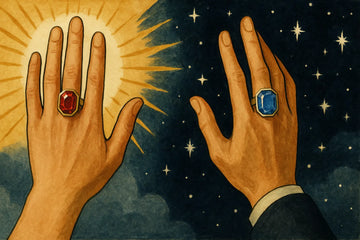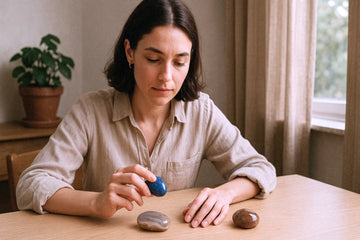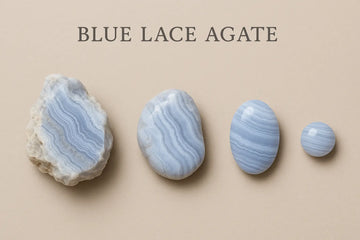The consultation felt more like a medical diagnosis than an astrological reading. Under the soft glow of a Himalayan salt lamp, Maya listened as the practitioner, a woman with kind eyes and a voice like calm water, delivered her prescription.
“For your anxiety, for that feeling of being ungrounded, you need the stabilizing energy of a red coral,” the woman said, her fingers tracing a chart filled with intricate symbols. “But it is crucial. It must be worn on the ring finger of your right hand. The right side is your active, projective side. It will help you push that energy out into the world, to build the confidence you seek.”
Maya, a logical-minded software engineer from San Francisco, felt a familiar internal conflict. The idea was beautiful, poetic even. But a question, stubborn and rational, pushed back. Why the right hand? What would happen if she wore it on the left? Was this an ancient truth, or an ancient tradition whose original reason had been lost to time?
She wasn’t just choosing a piece of jewelry. She was standing at the crossroads of a thousands-year-old belief system and the uncompromising scrutiny of modern science. She was asking a question about the body, the mind, and the stories we tell ourselves to navigate the world.
The Roots of the Rule: A Map of the Cosmic Body
The directive Maya received didn’t originate in a California wellness studio. Its roots burrow deep into the soil of Vedic astrology, or Jyotish, a system dating back over 5,000 years in the Indian subcontinent. In this worldview, the human body is a microcosm of the universe, a sacred map crisscrossed by channels of energy.
The most fundamental law of this map is the principle of “Left for Receiving, Right for Giving.”
The left side of the body is considered the receptive side—the intuitive, inward-looking, feminine side. It is the channel through which energy, influence, and vibrations from the cosmos and our environment are drawn into us. The right side is the active side—the logical, outward-expressing, masculine side. It is the channel through which we project our will, our energy, and our actions out into the world.
Therefore, the choice of hand is not arbitrary; it is diagnostic. A stone like a pearl (governed by the Moon) is worn on the left hand to cool the emotions and receive nurturing, calming energy. A stone like a ruby (governed by the Sun) is worn on the right to actively project vitality, confidence, and leadership.
“It is about balancing the flow of planetary energies through the individual,” explains a practicing Vedic astrologer. “The hand and finger are chosen with precise intention to either strengthen a weak influence or pacify a negative one. It is a science of energy, not of matter.”
The Scientific Rebuttal: The Silent Stone
Dr. Evelyn Reed, a materials scientist at a prominent university, holds a ruby under the bright light of her lab. Her world is one of electron microscopes, mass spectrometers, and X-ray diffraction machines.
“Let’s be clear,” she says, her tone not dismissive, but precise. “A gemstone is a remarkably beautiful arrangement of atoms. This ruby is primarily aluminum and oxygen with a dash of chromium that gives it that magnificent color. Its crystal structure gives it certain physical properties—hardness, refractive index. But the idea that it emits a ‘planetary energy’ or a ‘vibration’ that can be channeled based on which hand you wear it on? There is no mechanism in physics for that.”
She addresses the common counter-argument: the piezoelectric effect. “Yes, some crystals, like quartz, generate a tiny electric charge under direct, physical stress. This is how your quartz watch works. But it is not a passive, ambient energy field. The charge is negligible and only occurs under significant pressure. It is not flowing into your body from a ring on your finger.”
For science, the stone is silent. The body, however, is not.
The Third Path: The Theater of the Mind
If the energy isn’t in the stone, and the rule isn’t a scientific law, why have millions of people, like Maya, reported real, tangible effects?
The answer may lie in the most powerful laboratory we know: the human brain. This is the realm of the placebo effect, and it is anything but imaginary.
Dr. Arjun Patel, a neuroscientist who studies belief and perception, offers a different perspective. “The placebo effect is not about fooling yourself. It is about the real, measurable impact of belief and ritual on our neurochemistry. If you truly believe that wearing a red coral on your right hand will make you more confident, your brain can make it so. It can trigger the release of dopamine and endorphins, creating a genuine sense of well-being and agency.”
The ritual of choosing the stone, the intention behind it, and the physical reminder of its presence on your hand act as a constant, subconscious reinforcement of a desired state of being. The rule—the must of wearing it on a specific hand—isn’t a physical law; it’s a psychological catalyst. It makes the ritual more precise, the intention more focused, and therefore, the potential placebo effect more powerful.
The rule provides a structure for belief to work its magic.
The Modern Dilemma: Left Handed in a Right-Handed World
This brings us back to Maya’s original, practical question. What about left-handed people? Or ambidextrous people? Are they simply left out of this cosmic design?
Within traditional systems, the answer is usually that the “receiving” and “projecting” sides are intrinsic to the body’s design, independent of handedness. Your dominant hand is for doing, but your right side is still for projecting energy.
Yet, the modern interpretation is evolving. Many contemporary practitioners encourage a more intuitive approach. “The rules are a centuries-old guide,” says one wellness coach. “But your own intuition is your most powerful guide. If a stone feels right on a different hand, trust that. The intention is what matters most.”
The Verdict: A Story We Choose to Wear
So, what is the final answer? Is the left-hand/right-hand rule science or belief?
The scientific evidence is unequivocal: there is no detectable energy or physical mechanism that justifies the rule. From this perspective, it is a cultural tradition, a metaphysical belief.
But to dismiss it as just a false belief is to miss a deeper point. Humans are meaning-making creatures. We use stories, symbols, and rituals to navigate our inner worlds. The Vedic system provides a complex, sophisticated, and time-tested story for self-improvement.
Maya ultimately bought the red coral ring. She chose to wear it on her right hand, not because she was convinced by the physics, but because she was captivated by the story. The act of putting it on each morning became a ritual—a physical reminder to project confidence.
Does it work? For her, it does. Not because the ruby is charging her with solar energy, but because the ritual centers her. The belief unlocks her own innate capacity for change. The rule, in the end, is less about the flow of cosmic energy and more about the power of a narrative to focus the most powerful tool we possess: our own mind.



